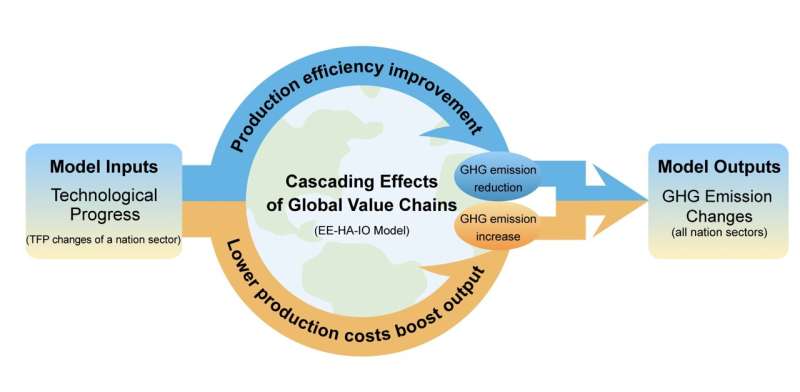This article has been reviewed according to Science X's editorial process and policies. Editors have highlighted the following attributes while ensuring the content's credibility:
fact-checked
peer-reviewed publication
proofread
Technological progress to climate change depends on positioning in global value chains

Technological progress can reduce the energy required to achieve the same ends, reducing the use of fossil fuels and the greenhouse gases associated with burning fossil fuels. But technological progress can also make production, consumption, and travel cheaper, stimulating demand and consequently increasing greenhouse gas emissions.
Sai Liang and colleagues sought to explore this conundrum by building an environmentally extended general equilibrium model with heterogeneous agent and input-output network covering 141 nations and 65 sectors, as defined by the Global Trade Analysis Project.
The authors of the study, published in PNAS Nexus, found that whether technological progress tended to decrease or increase emissions depended on its place in the value chain.
Progress in upstream sectors tends to result in increased emissions overall, while progress in downstream sectors tends to lower global emissions.
Technological progress in Russia's chemicals sector; China's gas sector; and China's, the United States', and South Korea's coal and petroleum sectors have significantly increased global emissions, whereas technological progress in China's sugar and construction sectors and the United States' dwelling and human health and social work sectors have significantly reduced global emissions. (The dwelling sector includes such activities as housing investment, residential construction, and residential real estate services; the human health and social work sector includes economic activities related to health care and social welfare services, such as medical laboratories, pharmacies, and services related to social assistance.)
According to the authors, the model could help national governments identify where technological progress can best help meet emissions reductions goals—and where policies might be needed to prevent the tendency for energy use to rebound after a technological advance increases consumption.
More information: Sai Liang et al, Double-edged sword of technological progress to climate change depends on positioning in global value chains, PNAS Nexus (2023). DOI: 10.1093/pnasnexus/pgad288
Journal information: PNAS Nexus
Provided by PNAS Nexus





















